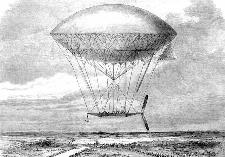UFO’s in the 1800’s

UFO’s in the 1800’s
In Mystery Airships in the Sky author Steven A. Arts explores the odd phenomena of UFO sightings that took place in 1896 and 1897. The stories began in Canada with possible sighting of a missing balloon that was trying to reach the North Pole. Later, sightings were reported in California of fantastical machines and even more fantastical claims of the “inventors”. Gradually the sightings of lights and machines in the skies were seen in the Midwest and then to some of the eastern states. Some people at the time claimed to be engineering a lighter than air craft, some claimed that people were seeing Venus or bright stars, some people saw or heard people in the aircraft and even had conversations with them. Many of the newspaper articles about the sightings seem to be used to ridicule public officials. While I find the book difficult to read it would be very helpful place to start your own UFO research.
Southwest Missouri was also visited. The Springfield Republican printed an article titled The Great Air Ship on the 16th of April 1897. This article says the air ships were a fact because it had been seen by responsible people. Judge J. A. Frink saw it from a train near Cabool, Mo. His description of it is that it was cigar shaped and designed as a dragonfly, with double wings. It had a lot of lights that were probably powered by electricity. It appeared to be made of aluminum and was equipped with a “Floroscope” so that the captain could look through roofs of houses as easily as through a window [though how he knew this is not explained].
Days later the ship was also seen in Springfield by George Pepperdine, Charles J. Wright, G. H. Cunningham and Frank B. Parker. These stories fall into the absurd political commentary as most of these men spoke to the occupants of the air ship. Some of the replies from the airship were:
- “McKinley was not satisfied with the reports of the recent municipal election in the Fourth ward of this city”
- “…the captain called out to me asking whether I had a Republican [newspaper] he wanted to see how the slot machine question was decided in the council.
- Mr. Parker, who did not see the air ship, said “they must have seen something or have been affected in the same way by something they had for supper, which went to their heads…” he also speculates that people were seeing “The Republican wave of prosperity”.
On the 17th of April the Republican printed “Mark Hanna’s Visit – F.S. Heffernan had talked with him over the wire –he was in the air ship—accompanied by Grover who asked about that fisherman—was certainly the real thing” This article is nearly pure politics and fanciful fiction, one of the best examples of yellow journalism I’ve ever read. Mark Hanna speaks to Heffernan by dropping a telephone to him from the air ship. It becomes even stranger after that as Hanna tells of his future political plans and Grover [Cleveland?] tries to spit on the Robberson Avenue car house which housed the willipus wallapus [a controversial road paving machine]. This article is full of what appear to be local jokes though very obscure to a modern audience.
On the 20th of April a short note in the “News from Sparta” section mentions that two merchants saw the wonderful flying machine and that it struck a straw stack. The merchants held a conversation with the captain but declined to give details of the conversation. This may have been leading up to another aspect of the air ships –advertising. On the 22nd the paper printed in large letters Air ship- mystery -solved in very large type. In between the large type is an advertisement for a couple of physicians who ran the Polypathic Institute in Springfield. In that same paper was an article about an Iowa farmer who was accidently hooked in the seat of the pants by an air ship's anchor or grapnel and carried him some way before he could grab a tree at which point the grapnel tore his pants and he fell into a ditch.
If you search the Historical New York Times newspaper online [requires a valid library card] you will see that air ships were mentioned as early as June of 1890…”A new airship…the machine in which a man expects to sail across Niagara”. As late as August of 1897 the Times had an article about Charles A. Kuenzel of Hoboken who was planning to sail his air ship to the Klondike gold fields, the plan was to fly to San Francisco in two days and on to the Klondike in the same amount of time. Kuenzel spoke of stopping by Washington to collect a $100,000.00 premium offered by the Government for a successful air ship. Truth or fiction it makes for interesting reading.
Find this article at http://thelibrary.org/blogs/article.cfm?aid=312&lid=31